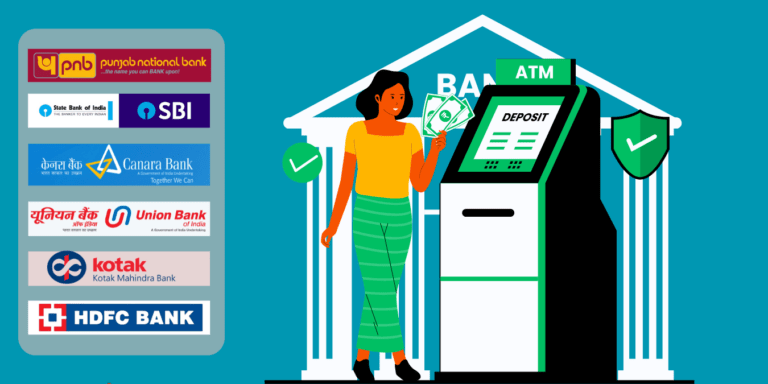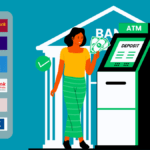
Hidden current account traps that could spark income tax scrutiny in India! With RBI’s tightened rules and AI-driven audits flagging ₹50 lakh cash deals, your business might be one transaction away from a tax notice. From dormant accounts to ₹30 lakh property buys, this guide reveals high-risk moves and offers expert compliance tips.
Current accounts serve as the lifeline for businesses, entrepreneurs, and professionals. These accounts facilitate seamless daily operations, from vendor payments to client receipts, without the constraints often seen in savings accounts. However, with the Reserve Bank of India (RBI) rolling out updated guidelines and the Income Tax Department leveraging advanced AI for monitoring, 2025 has ushered in heightened vigilance. As per the latest data from the Central Board of Direct Taxes (CBDT), over 1.6 lakh Income Tax Returns (ITRs) were selected for scrutiny in the first half of 2025 alone, a 15% increase from the previous year, largely due to discrepancies in high-value transactions reported via the Statement of Financial Transactions (SFT).
This comprehensive guide, viewed through an Indian lens, delves into the nuances of current account regulations, identifies red-flag activities that could prompt tax audits, and offers practical strategies for compliance. Drawing from real-time updates—like the RBI’s June KYC revisions and the new Income Tax Bill proposing broader data access—we’ll explore how to navigate these rules without disrupting business flow. Whether you’re a Mumbai-based trader or a Bengaluru startup founder, understanding these elements can prevent unwanted notices and foster financial peace.
Understanding Current Account Rules in India (2025)
What is a Current Account?
A current account is essentially a demand deposit account tailored for commercial entities in India. It’s designed for high-frequency transactions, making it ideal for firms handling inventory purchases, salary disbursals, or export-import dealings. Unlike savings accounts, which cap transactions and offer interest, current accounts provide unlimited withdrawals, cheque facilities, and overdraft options—crucial for maintaining liquidity in volatile markets like those in Delhi’s wholesale hubs or Chennai’s manufacturing sectors.
As of 2025, current accounts remain interest-free, as reaffirmed in the RBI’s Interest Rate on Deposits Directions issued on April 1, 2025. This policy ensures they stay focused on operational needs rather than savings. For small businesses in rural India, such as a Kerala spice exporter, this means quick access to funds without interest accruals complicating tax filings.
Latest RBI Guidelines for Current Accounts (2025)
The RBI has refined its framework to promote financial stability amid rising digital frauds and economic uncertainties. Key updates effective in 2025 build on the 2020 circulars but incorporate fresh measures for dormancy, KYC, and exposure limits.
- Aggregate Exposure Limits: Businesses with total banking credit below ₹5 crore can maintain current accounts with multiple banks, offering flexibility for diversified operations. This is a boon for SMEs in Gujarat’s textile industry, allowing them to shop for better services.
- One Account Rule for Large Borrowers: Entities with exposures of ₹50 crore or more must consolidate to a single escrow-managing bank. This curbs misuse, as seen in cases where firms routed funds through non-lending banks to evade oversight.
- Dormancy and Inactivity Norms: From January 1, 2025, accounts inactive for 12 months are labeled “inactive,” restricting operations until reactivation. After 24 months, they become “dormant” and face closure, per RBI’s new guidelines aimed at cleaning up the banking system. This affected over 2 crore accounts nationwide in early 2025, prompting banks to send reactivation alerts.
- Robust KYC Mandate: The RBI’s June 9, 2025, Master Direction on KYC mandates periodic updates, now simplified for low-risk customers with extensions to June 30, 2026. Video KYC, branch visits, or business correspondents can suffice, reducing paperwork for professionals like Hyderabad IT consultants.
- Purpose-Driven Restrictions: Non-lending banks cannot open current accounts unless designated for collections. Term loan repayments must bypass Cash Credit (CC) or Overdraft (OD) accounts, ensuring transparency. The June 19, 2025, circular emphasizes principle-based regulation, urging banks to align policies by July 1, 2025.
- Regular Monitoring and Compliance: Banks now employ AI for real-time transaction tracking, reporting suspicious activities to the Financial Intelligence Unit (FIU). This aligns with the RBI’s push for a resilient banking sector, especially post the 2024 cyber incidents.
These rules reflect India’s shift towards a digitized economy, where UPI and NEFT dominate, but cash still lingers in traditional sectors like Punjab’s agriculture.
Indian Stock Market Forecast: What’s Next for Nifty50, Bank Nifty, and Top Stocks on Thursday?
No Medical Tests, Lower Premiums: The Secret Advantage of Buying Health Insurance Early
Indian Stock Market Outlook for April 15, 2025: Nifty50 and Bank Nifty Predictions
How Did SBI Smash ₹100 Trillion and Join the $100 Billion Club in 2025?
High-Value Transactions: The Red Flags
What Triggers Income Tax Scrutiny in 2025?
With the Income Tax Department's AI-driven risk profiling, scrutiny has intensified. The CBDT's guidelines for FY 2025-26, released July 3, 2025, prioritize mismatches in ITRs versus the Annual Information Statement (AIS) and Taxpayer Information Summary (TIS). High-value transactions in current accounts are auto-flagged through SFT under Section 285BA, with banks reporting directly to authorities.
In 2025, notices surged due to the new Income Tax Bill (February 13, 2025), granting officials access to emails, social media, and devices during searches. This has led to 1.6 lakh scrutinized returns, focusing on undeclared incomes and disproportionate spends.
Common Transactions That Can Attract Scrutiny
Here's a tabulated overview of SFT reporting thresholds, unchanged in 2025 but enforced more stringently:
| Transaction Type | Reporting Trigger Amount (₹) | Reporting Authority |
| Cash deposit/withdrawal (Current A/c) | 50,00,000 per FY | Banks/Co-operatives |
| Cash deposit (Savings A/c) | 10,00,000 per FY | Banks/Post Offices/Co-ops |
| Purchase/Sale of immovable property | 30,00,000 | Registrar/Sub-Registrar |
| Payment for credit card (cash) | 1,00,000 per annum | Banks |
| Payment for credit card (other) | 10,00,000 per annum | Banks |
| Investment in shares/mutual funds/bonds (cash) | 10,00,000 | Companies/Mutual Funds |
| Receipt of cash for goods/services | 2,00,000 | Audited Businesses |
| Foreign exchange purchase/FOREX card | 10,00,000 | Authorized Dealers |
Exceeding these invites inquiries if income declarations don't match. For instance, forex buys over ₹10 lakh are cross-verified with travel or business proofs.
Real-Life Scenarios: Indian Case Studies
- A trader receives and withdraws over ₹60,00,000 in his current account within a year; this triggers automatic reporting, especially if his business turnover or declared income appears disproportionately low compared to the movement in his account.
- A professional pays a credit card bill of ₹1,20,000 in cash; the bank files this with the income tax department, and if unexplained, it leads to scrutiny.
- A salaried employee regularly deposits cash well above ₹10,00,000 in her savings account, while her Form-16 declares only ₹8,00,000 as annual income. This mismatch invariably leads to tax queries and possible penalties.
Top Transactions to Avoid or Carefully Document
Cash Deposits and Withdrawals
- Limit large cash transactions: Any cash deposits or withdrawals above ₹50 lakh per financial year in a current account will always be reported to tax authorities.
- Maintain supporting documents: Ensure all cash transactions are backed by robust documentation (invoices, contracts).
High-Value Payments and Receipts
- Credit card bills: Paying more than ₹1 lakh in cash or over ₹10 lakh non-cash in a financial year requires explanation and coherence with your reported income.
- Goods and services in cash: No person subject to audit under section 44AB should receive ₹2 lakh or more in cash for a single transaction.
Property and Asset Transactions
- Real estate transactions above ₹30 lakh are cross-verified with your PAN and must reflect correctly in your ITR.
- Share and bond investments: Sizable investments purchased in cash may invite queries if they are not in sync with income disclosures.
Digital Footprint and Data Matching
Annual Information Statement (AIS) and SFT
Every significant transaction is now captured automatically in the taxpayer’s Annual Information Statement (AIS) via SFT reporting. Mismatches between AIS data and your ITR will rapidly lead to notices.
- Example: If a business owner’s current account statement shows payments worth ₹70 lakh in a year but declares a turnover of only ₹35 lakh in the ITR, this anomaly is instantly flagged.
Common Reasons for Scrutiny in 2025
- ITR vs. AIS/TIS Mismatches: All data must sync; over-reliance on Form 16 ignores bank interest or dividends.
- Disproportionate Activity: High transactions relative to income, like luxury spends on modest salaries.
- Non-Disclosure: Undeclared commissions or rentals via current accounts.
- Suspicious Patterns: Frequent large transfers, per the June 16, 2025, CBDT guidelines on verifying bank accounts.
Avoiding Income Tax Scrutiny: Golden Rules
File Accurate and Timely Returns
- Furnish all sources of income, including those reflected only in current accounts.
- Cross-verify TDS entries: Match TDS reported in Form 26AS/AIS with your own records.
Avoid Cash for High-Value Deals
- Use banking channels for all payments above the prescribed reporting limits.
- Document every large transaction with valid, traceable invoices and agreements.
Transparent Record Keeping
- Maintain books of account, especially when frequent or high-value current account transactions are involved.
- Retain digital evidence such as emails, contract scans, and payment confirmations.
Reconcile and Verify Your AIS
- Check your AIS before filing the ITR to ensure all bank-reported data (including current account inflows and outflows) match your disclosures.
RBI Compliance and KYC
- Complete all KYC formalities periodically as asked by the bank to avoid the risk of your current account being frozen or closed; this includes address proof, PAN, Aadhar, and nature of business updates.
- Keep current accounts active: Inactivity for over 12 months risks ‘inactivation,’ while more than 24 months will result in the account being declared ‘dormant’ and eventually closed.
Pro Tips for Indian Business Owners & Professionals
Multiple Current Accounts: What’s Allowed?
- RBI allows multiple current accounts only if your aggregate banking exposure is below ₹5 crore. Exceeding this threshold demands route consolidation and single-bank relationship management.
Routing of Transactions
- Don’t use current accounts with non-lending banks for business settlements unless they are officially permitted as collection accounts.
- Proper routing of loan repayments—use only approved channels, and avoid term loan servicing via CC/OD current accounts except in specific cases.
Stay Updated on Regulatory Changes
- 2025 Banking rules now include stricter ATM withdrawal limits, new digital banking features, Positive Pay System, and revised audit requirements.
- Monitor RBI and CBDT circulars regularly for adjustments that may affect permissible use of current accounts.
Final Thought
Navigating current account usage requires clarity, discipline, and awareness. With AI-powered tax scrutiny and stricter banking compliance, even minor gaps or unexplained financial activity in current accounts can lead to inconvenient queries—or worse, penalties. Stick to digital payment channels, avoid cash, maintain comprehensive records, and always cross-check your AIS and ITR data before submission.
By following the RBI’s latest current account rules and staying alert to the types of transactions that trigger scrutiny, Indian businesses and self-employed professionals can seamlessly manage their finances, steer clear of tax trouble, and focus on growth with complete peace of mind.
































